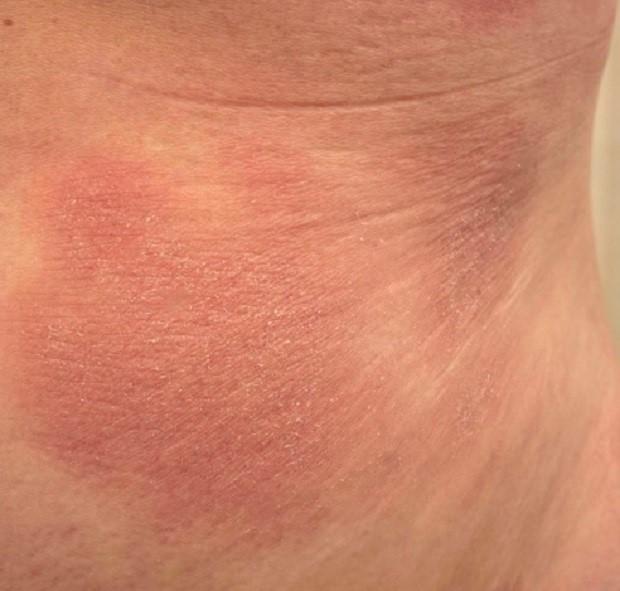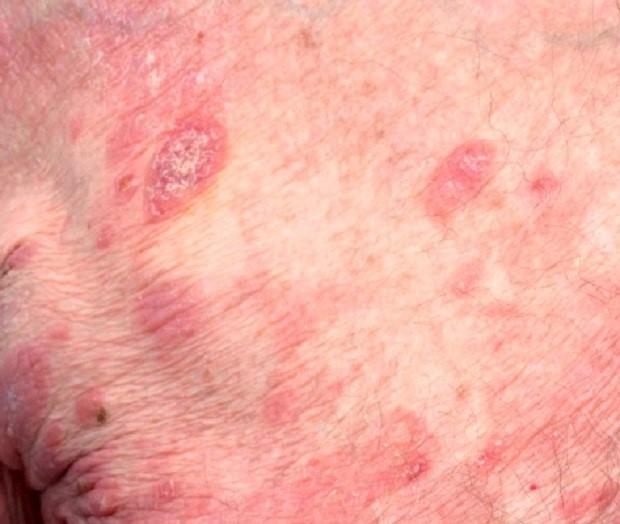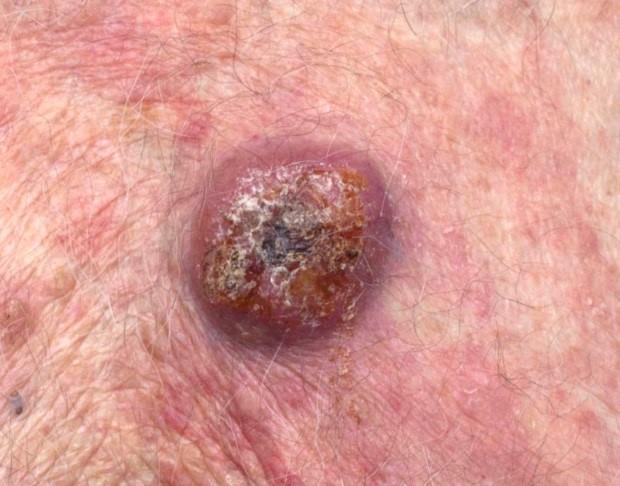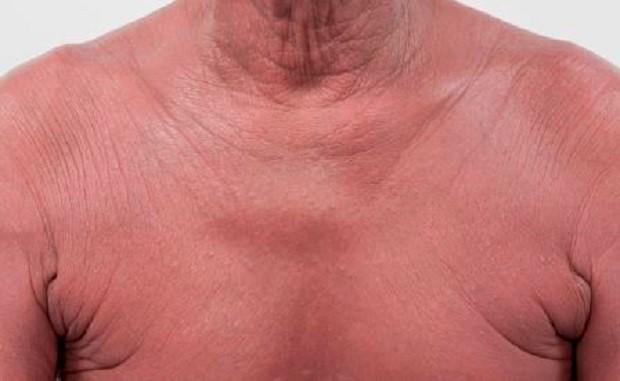Skin lymphoma
Skin lymphoma (cutaneous lymphoma) is a rare condition. It can be hard to diagnose as it often looks like other skin conditions such as rashes, eczema and psoriasis.
This page may be helpful if you are worried you could have skin lymphoma or if your doctor suspects that you may have it. If you have already been diagnosed with skin lymphoma and you know which type you have, you might find our information on cutaneous B-cell lymphoma or cutaneous T-cell lymphoma helpful.
On this page
What is skin lymphoma?
Lymphoma is a cancer that starts in white blood cells called lymphocytes, which are part of your immune system.
There are many different types of lymphoma. Skin lymphomas (also known as ‘cutaneous’ lymphomas) are lymphomas that develop in the skin and are not affecting any other areas of the body at the time they are diagnosed. Skin lymphoma is not a type of skin cancer (where the cancer develops from skin cells).
There are two types of lymphocytes: B lymphocytes (B cells) and T lymphocytes (T cells). Skin lymphomas can develop from either T cells or B cells.
- Cutaneous T-cell lymphomas (CTCLs) or T-cell skin lymphomas are the most common kind of skin lymphoma. T-cell skin lymphomas often look red and dry like an eczema rash and can affect widespread parts of the body.
- Cutaneous B-cell lymphomas (CBCLs) or B-cell skin lymphomas more commonly cause lumps in the skin, usually in one or two areas of the body.
Most skin lymphomas are slow-growing (low-grade) but some can be fast-growing (high-grade).
Lymphoma that starts somewhere else in the body (for example, in the lymph glands, bone marrow, liver or gut) and then spreads to the skin is not a skin lymphoma. If you have a lymphoma that has spread to the skin, our information on the particular type of lymphoma you have will be more relevant for you.
Who gets skin lymphoma?
Skin lymphomas are rare. In the UK, around seven people in every million develop a skin lymphoma each year. T-cell skin lymphomas make up about 7 in 10 cases of skin lymphoma.
In general, skin lymphomas are slightly more common in men than women. They are usually diagnosed in older people, most often those aged between 50 and 74. Only about 1 in 5 skin lymphomas affect people under 50. Very rarely, some types of skin lymphoma can develop in children.
Doctors don’t know exactly what causes skin lymphoma. Research has shown that:
- it isn’t caused by anything you’ve done
- it isn’t passed down in families (inherited)
- you can’t catch it or pass it on.
What does skin lymphoma look like?
Different types of skin lymphoma can look quite different from one another, particularly in the early stages.
This section includes photographs to illustrate the appearance of skin lymphomas. However, do not be alarmed if your skin has a similar appearance. There are many more likely and less serious skin conditions that may look similar, but can only be distinguished from skin lymphoma using specialised tests on the cells of the affected skin.
T-cell skin lymphomas
The most common skin lymphoma is a T-cell skin lymphoma called mycosis fungoides. At an early stage, patches of dry, discoloured (usually red) skin often appear. They can look like more common skin conditions such as dermatitis, eczema or psoriasis.
The patches tend to be dry, sometimes scaly and may be itchy. They are most common on the buttocks or between the waist and shoulders (the torso), but can occur anywhere on the body. T-cell skin lymphomas can develop as patches of lighter or darker skin tone, particularly on Asian or black skin.

Areas of skin can become harder and thicker but still remain quite flattened. These are called plaques. They can be itchy and sometimes ulcerate (break down). They are most common on the buttocks, in folds of skin and on the face. In many people the skin lymphoma never develops beyond the patch and plaque stage.

Some people develop much larger, raised swellings in the skin, called nodules or tumours. These can ulcerate (break down) and become infected.

Some people with T-cell skin lymphoma develop erythroderma: generalised reddening of the skin, which can be intensely itchy, dry and scaly. The skin on the palms of the hands and soles of the feet can thicken and crack. Lymph nodes may also swell, often in the neck, armpits or groin.

B-cell skin lymphomas
B-cell skin lymphomas are much less common than T-cell skin lymphomas. They are most likely to appear on the head, neck, back or legs. You may have small, raised, solid areas of skin (papules) or flatter, thickened areas of skin (plaques). Some people have larger lumps called nodules or tumours, which are often deep-red or purplish in colour. They can ulcerate and become infected. You may only have one or two nodules but you may have several, either grouped together or more widely spread out.

How is skin lymphoma diagnosed?
Skin lymphoma is difficult to diagnose as it can develop slowly, sometimes over decades, and often resembles more common skin conditions. These include:
- skin diseases and conditions, such as
- eczema or atopic dermatitis
- psoriasis
- lichen planus
- lupus erythematosus
- a group of rashes of unknown cause, such as chronic superficial dermatitis, digitate dermatosis or parapsoriasis
- granulomatous skin diseases such as sarcoidosis or granuloma annulare
- intertrigo
- fungal skin infections, such as ringworm (tinea corporis)
- skin reactions to
- substances in contact with the skin, such as metals (for example, nickel in jewellery or buttons) or cosmetics; this type of reaction is called ‘contact dermatitis’
- drugs, which can cause a widespread rash or even erythroderma
- sunlight (photosensitivity), particularly on the exposed skin of the face; this is called ‘actinic reticuloid’ or ‘chronic actinic dermatitis’
- lymphocytoma cutis, also known as ‘pseudolymphoma’, which can be triggered by
- drugs (sometimes called a ‘drug eruption’)
- vaccinations
- some infections, such as shingles
- tattoo dyes
- insect bites
- scabies.
You might be diagnosed with one of these conditions at first, or your doctor might mention them to you while they are working out your exact diagnosis.
For 17 years I was misdiagnosed and treated for a variety of different skin conditions; eczema, ichthyosis, tinea versicolor, vitiligo and dry skin.
The treatments for some of these other conditions (for example, steroid creams) can also be used to treat skin lymphoma. This means that even if you are treated for a different condition, your skin might improve for a while. This may delay the time it takes before a skin lymphoma is suspected. Some people make many visits to the GP or skin clinic before getting a final diagnosis.
Even if your doctor suspects a skin lymphoma, you may need to have tests repeated several times before the diagnosis is confirmed. On average it takes around three years to get a confirmed diagnosis of skin lymphoma. However, it might take considerably more or less time. Fortunately, early treatment is not critical for skin lymphomas and they tend to respond well to available treatments.
Who diagnoses skin lymphoma?
Diagnosing skin lymphoma is a bit like solving a jigsaw puzzle. A team of people from different hospital departments are involved in identifying the pieces and putting them together. This might include a dermatologist (skin specialist), haematologist (a specialist in diseases of the blood, including lymphoma), or clinical oncologist who specialises in lymphoma (a specialist in treating people who have lymphoma with treatments that don’t involve surgery) and other healthcare professionals, who work as part of a multidisciplinary team (MDT). You might only meet a few of these people but they are all involved in diagnosing your condition and recommending the best treatment for you.
History and examination
Your doctor asks you about your skin condition (the ‘history’), including:
- how it developed
- how it affects you
- how long you’ve had it
- whether it is itchy
- whether it comes and goes
- whether you’ve noticed anything that makes it better or worse
- whether it has got gradually worse.
They also ask about your general health and whether you’ve had any other symptoms, such as weight loss or fevers. They inspect your skin closely and do a general physical examination. This may include feeling your neck, armpits and groin to check if you have any swollen lymph nodes. You might have your skin photographed by a medical photographer.
Your specialist may want to monitor your skin over a few months at outpatient clinic appointments. This is because it is important to build up a picture of the condition over time.
Tests for skin lymphoma
The most important test for diagnosing a skin lymphoma is a skin biopsy. The doctor numbs an affected area of your skin with a local anaesthetic and removes a small sample. This is sent to the laboratory to be examined under a microscope and for specialised genetic tests.
Results can take 4 to 6 weeks to come back. Quite often the biopsy results aren’t clear-cut. You may need to have several biopsies over months or even years to confirm a diagnosis. This can be a frustrating and anxious time, but it is important to get the right diagnosis so that you can have the most suitable treatment. We have information summarising what happens when you’re waiting for test results, as well as giving suggestions to help you cope with the wait.
You might also have other tests, such as blood tests, a CT scan or a PET/CT scan. You may have other biopsies, for example a lymph node biopsy or bone marrow biopsy. You are only likely to have these if the results of your skin biopsy suggest that you have a skin lymphoma.
After diagnosis
Although skin lymphomas are a form of cancer, in many cases they are very slow growing and do not affect life expectancy. They behave more like a long-term (chronic) skin condition than a cancer.
Many people with a slow-growing skin lymphoma don’t need treatment straightaway. Instead, the doctor monitors the condition. This is called ‘active monitoring’ or ‘watch and wait’. It is often used for early-stage lymphoma that would not benefit from treatment.
Many people find active monitoring very difficult to cope with. It can be hard to wait for repeat appointments and tests, and then hear that having no treatment is the best option for you at that time. However, research and many years of experience have shown that this is the best approach for some types and stages of skin lymphoma.
If your specialist feels that treatment would help you, there are many different options. Some treatments are applied directly to affected areas of your skin (topical treatment), such as creams, lotions or ointments, light therapy or radiotherapy. Other treatment affects your whole body (systemic treatment), such as immunotherapy (drugs that use your own immune system to help your body get rid of lymphoma cells), steroids, chemotherapy or, rarely, a stem cell transplant. If you have skin lymphoma affecting a single area of skin, you might have surgery to remove the lymphoma. The treatment you need depends on the type of skin lymphoma you have and on how much of your body is affected.
If you have been diagnosed with skin lymphoma, you can find more detail on the treatment you might have on our pages about specific skin lymphomas:
- cutaneous T-cell lymphomas (CTCLs), including mycosis fungoides and Sézary syndrome
- cutaneous B-cell lymphomas (CBCLs).
What happens if it isn’t lymphoma after all?
Your specialist might have discussed the possibility of a skin lymphoma with you and you might have prepared yourself to be diagnosed with a type of cancer. After monitoring your skin and carrying out tests, your specialist may find that you actually have a benign (non-cancerous) skin condition.
Although you might expect to be pleased with this news, some people find it emotionally difficult to cope with. If you find it hard coming to terms with your diagnosis, talk to your doctor or specialist nurse. They have helped people in your situation before and can explain what happens next.
If you have been referred to a specialist centre for skin lymphoma and they are unable to confirm the diagnosis, you are likely to be referred back to your local specialist for more monitoring. If this further monitoring still raises the possibility of skin lymphoma, you might be referred back to the specialist centre.
Whether or not you have a skin lymphoma, you may be struggling to cope with symptoms or changes in the appearance of your skin. You might find it helpful to contact a specialist organisation working with people affected by visible skin conditions.

